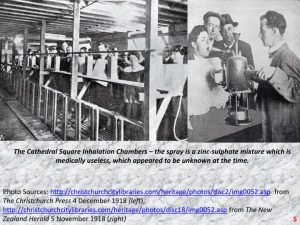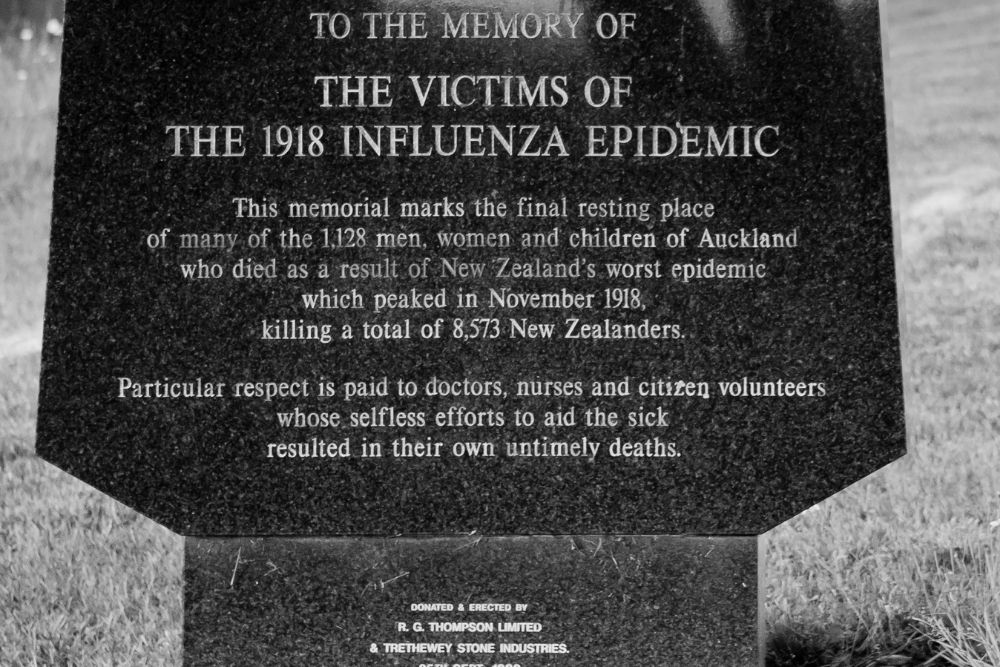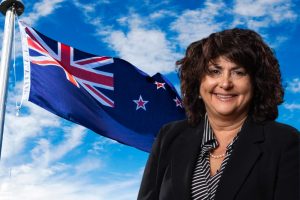The Influenza Pandemic of 1918, commonly known as the Spanish Flu, hit New Zealand very hard in the months of October through early December of that year. In the rush to stave off illness and prevent death, various innovative preventive and therapeutic treatments were authorised by health officials. One of these were made a condition of travel. A retrospective view of two of the most widely applied and approved treatments is informative. It also demonstrates clearly that some practices that were once considered safe and effective, have subsequently proved to have been neither.
Background
The 1918 wave of the influenza virus is estimated to have claimed around 9,000 people in 2 months, compared with the 18,000 that New Zealand lost in the First World War over 4 years. It was the 2nd wave of the virus that was the deadliest, the 1st wave having arrived at the start of the year and from which most of the people affected, recovered. Unlike previous waves of the flu, this 1st wave affected mainly young and healthy adults.
There is speculation that the 2nd wave of the virus was either a mutation of that which caused the 1st wave, or a hybrid result of the virus already in NZ combined with a new strain imported by travellers. Historian Geoffrey Rice noted that certain communities were less affected than others, likely because of prior recent infection in the 1st wave. The most isolated rural areas and many Maori communities were the hardest hit; the death toll among these was the highest at almost 50 per thousand people.
Formalin Gas or Formaldehyde
Formaldehyde is colourless, poisonous gas that is commonly used as an antiseptic, disinfectant, histologic fixative and general purpose chemical reagent for laboratory applications. Formaldehyde is classified as a known human carcinogen based on elevated risks of nasopharyngeal cancer and leukemia. Some people are very sensitive to formaldehyde, but others have no reaction to the same level of exposure.
At the height of the epidemic in Auckland, the Health Officer for Coromandel Peninsula Major J. Lovell Gregg, a member of the NZ Medical Council, set up 6 “inhalation chambers” to keep the Coromandel free of the virus. Travellers to the Coromandel were required to produce medical certificates to prove they had been examined and declared free of the virus. They then had to be placed in inhalation chambers before being allowed to proceed.
Each inhalation chamber was “6ft. x 6ft., and half-a-dozen saucers with cotton wool soaked in 40 per cent formalin were scattered round the room. The caretaker kept the passengers in five minutes.”, according to a retrospective article published in the NZ Medical Journal.
Children from the local high school were also required to inhale the formalin fumes. Major Gregg proudly writes that, “Amongst the children the ordinary coughs and catarrhs of the throat were cured, and mothers soon found that out.”
Zinc Sulphate Solution Aerosol

Zinc sulphate is a common inorganic compound that is used to provide trace element supplementation for humans, in fertilisers and animal feed. Zinc sulphate solution is sold as a prepared product. One MSDS (Material Safety Data Sheet) found for this states that direct eye contact may cause mild eye irritation and that dried residues may cause eye, nose and throat irritation. It also states that “acute inhalation of mists will result in irritation of the nose, throat and upper respiratory passages. Symptoms may include discomfort, coughing, tingling sensation, sneezing and/or shortness of breath and wheezing.”
Inhalation of zinc sulphate aerosol was also the only approved preventative for influenza by the New Zealand Public Health Department in 1918. Although now known to have been medically useless, sealed chambers containing inhalation sprayers, dispersing a solution of zinc sulphate, were set up in many towns and cities.
According to the New Zealand Ministry for Culture and Heritage, “Most sprayers were set up in public buildings. They were made even more accessible in Christchurch after someone observed that the compressed-air braking units on trams ‘could be adapted to operate a sprayer by reconnecting a few hoses’. Eventually 14 trams were converted and ‘stationed on loops at the end of all major routes, handily placed to serve the outlying districts’. Some local authorities regularly disinfected streets and public buildings during the pandemic.”
In Ashburton, the Health Inspector set up an inhalation chamber and required “Persons desiring to travel by train must obtain a certificate from the Inspector that they have been through the chamber.” One man’s personal account after the experience stated, “…it didn’t do me any good. I don’t think it did anybody any good. And as for stopping the epidemic, they found out after that it was only egging it on! It was making it worse! If you weren’t going to have it – you were more likely to have it having this treatment. So, after a bit they knocked that off sudden!”
Sources:
https://pubchem.ncbi.nlm.nih.gov/compound/formaldehyde
https://www.cancer.org/cancer/cancer-causes/formaldehyde.html
https://journal.nzma.org.nz/journal-articles/how-coromandel-kept-the-influenza-epidemic-at-bay
https://www.teck.com/media/2015-Products-Zinc_Sulphate_Solution_SDS-T2.6.pdf
‘Response to the influenza pandemic’, URL: https://nzhistory.govt.nz/culture/1918-influenza-pandemic/response, (Ministry for Culture and Heritage), updated 22-Apr-2020
‘Inhalation chamber during the 1918 influenza pandemic’, URL: https://nzhistory.govt.nz/media/sound/influenza-inhalation-chamber, (Ministry for Culture and Heritage), updated 8-Jan-2015
https://paperspast.natlib.govt.nz/newspapers/AG19181114.2.12.1 (ASHBURTON GUARDIAN, VOLUME XXXIX, ISSUE 9451, 14 NOVEMBER 1918, PAGE 4)
Image source here.










